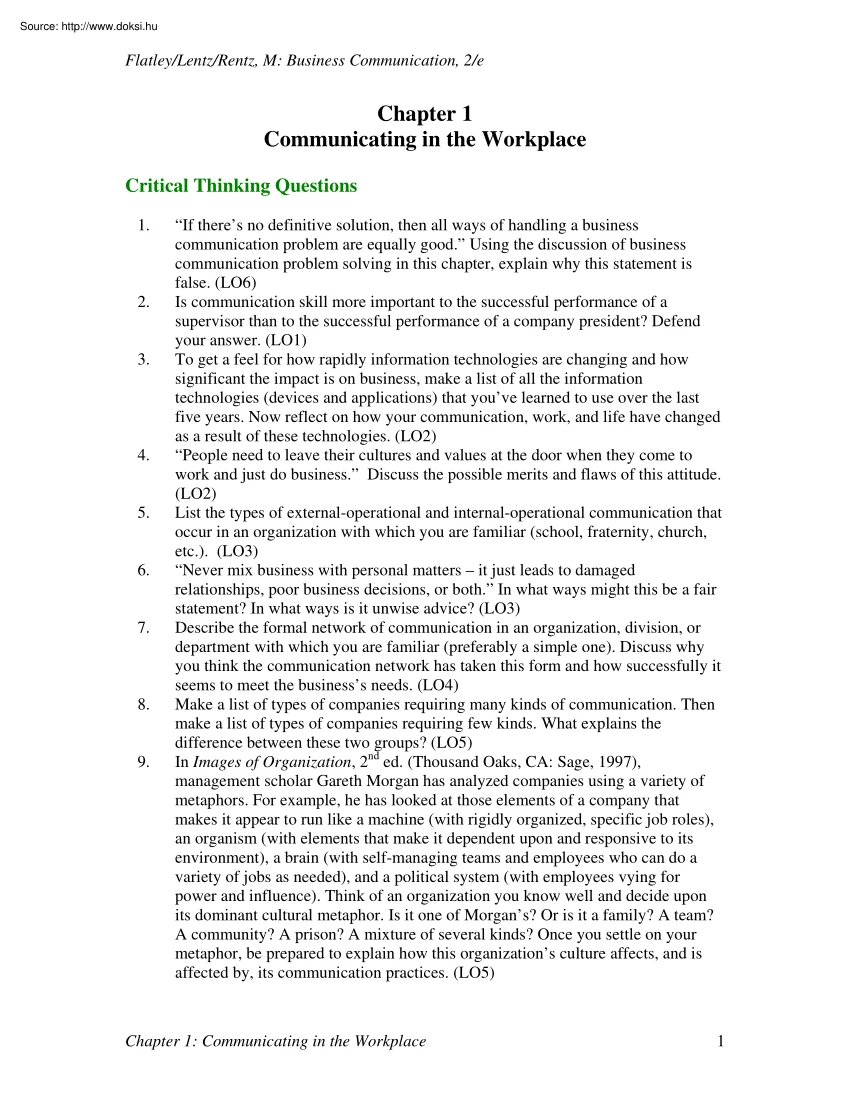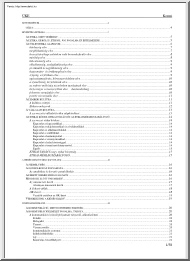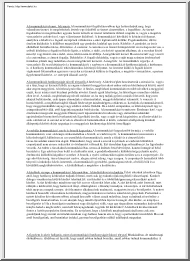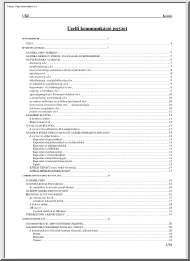Datasheet
Year, pagecount:2010, 3 page(s)
Language:English
Downloads:12
Uploaded:March 28, 2013
Size:29 KB
Institution:
-
Comments:
Attachment:-
Download in PDF:Please log in!
Comments
No comments yet. You can be the first!Most popular documents in this category
Content extract
Flatley/Lentz/Rentz, M: Business Communication, 2/e Chapter 1 Communicating in the Workplace Critical Thinking Questions 1. 2. 3. 4. 5. 6. 7. 8. 9. “If there’s no definitive solution, then all ways of handling a business communication problem are equally good.” Using the discussion of business communication problem solving in this chapter, explain why this statement is false. (LO6) Is communication skill more important to the successful performance of a supervisor than to the successful performance of a company president? Defend your answer. (LO1) To get a feel for how rapidly information technologies are changing and how significant the impact is on business, make a list of all the information technologies (devices and applications) that you’ve learned to use over the last five years. Now reflect on how your communication, work, and life have changed as a result of these technologies. (LO2) “People need to leave their cultures and values at the door when they come
to work and just do business.” Discuss the possible merits and flaws of this attitude (LO2) List the types of external-operational and internal-operational communication that occur in an organization with which you are familiar (school, fraternity, church, etc.) (LO3) “Never mix business with personal matters – it just leads to damaged relationships, poor business decisions, or both.” In what ways might this be a fair statement? In what ways is it unwise advice? (LO3) Describe the formal network of communication in an organization, division, or department with which you are familiar (preferably a simple one). Discuss why you think the communication network has taken this form and how successfully it seems to meet the business’s needs. (LO4) Make a list of types of companies requiring many kinds of communication. Then make a list of types of companies requiring few kinds. What explains the difference between these two groups? (LO5) In Images of Organization, 2nd ed. (Thousand
Oaks, CA: Sage, 1997), management scholar Gareth Morgan has analyzed companies using a variety of metaphors. For example, he has looked at those elements of a company that makes it appear to run like a machine (with rigidly organized, specific job roles), an organism (with elements that make it dependent upon and responsive to its environment), a brain (with self-managing teams and employees who can do a variety of jobs as needed), and a political system (with employees vying for power and influence). Think of an organization you know well and decide upon its dominant cultural metaphor. Is it one of Morgan’s? Or is it a family? A team? A community? A prison? A mixture of several kinds? Once you settle on your metaphor, be prepared to explain how this organization’s culture affects, and is affected by, its communication practices. (LO5) Chapter 1: Communicating in the Workplace 1 Flatley/Lentz/Rentz, M: Business Communication, 2/e 10. 11. 12. As noted in this chapter,
companies develop specific forms of communication, or genres, that enable them to get their work done. In a place where you have worked or another organization you have been a member of, what were the main forms of communication with the employees or members? To what extent were these uniquely adapted to the needs of the organization? (LO5) Think of a recent transaction you had with a business person or with a staff person at your school. Describe the contexts of your communication, from the larger context (business-economic, sociocultural, and historical) down to the personal (to the extent you know them). How did these influence the outcome of your communication? (LO7) Using this chapter’s discussion of communication, explain how people reading or hearing the same message can disagree on its meaning. (LO7, LO8) Critical Thinking Exercises 1. 2. 3. 4. 5. Watch the video “Did You Know?” at <http://www.youtubecom/watch?v=pMcfrLYDm2U> Using the content of Chapter 1 to
aid you, describe what kinds of skills one will need in order to survive and thrive in this quickly changing world. (LO2) Using the Internet, find a company that has a corporate social responsibility program and study what the company’s website says about that program. What kind of image as a corporate citizen is the company trying to project, and how? How convincing is this effort, in your opinion, and why? (LO2) Choose a certain national or regional culture, ethnicity, or generationone different from your ownand find out what values the people in this demographic are generally known for. How might working or doing business with a person from one of these groups require you to adapt your own values and communication style? (LO2) Find two websites of companies in the same industry – for example, two manufacturers of household products or two wireless service providers. Using the evidence presented on their websites, compare their company cultures. Look at their stated mission (if
any), their history (if provided), the gender and qualifications of their personnel (if given), their employee benefits, their information for job applicants, their information for investors, the company image projected by the visual elements on the site – anything that suggests who they are or want you to think they are. Write up your comparison in a well-organized, well-supported message to your instructor. (LO5) Megan Cabot is one of 12 workers in Department X. She has strong leadership qualities, and all her coworkers look up to her. She dominates conversations with them and expresses strong viewpoints on most matters. Although she is a good worker, her dominating personality has caused problems for you, the new manager of Department X. Today you directed your subordinates to change a certain work procedure. The change is one that has proven superior whenever it has been tried. Soon after giving the directive, you noticed the workers talking in a group, with Megan the obvious
leader. In a few minutes she appeared in your Chapter 1: Communicating in the Workplace 2 Flatley/Lentz/Rentz, M: Business Communication, 2/e 6. office. “We’ve thought it over,” she said “Your production change won’t work” Explain what is happening. How will you handle this situation? (LO4, LO6) After noticing that some workers were starting work late and finishing early, a department head wrote this message to subordinates: It is apparent that many of you are not giving the company a full day’s work. Thus, the following procedures are implemented immediately: a. After you clock in, you will proceed to your workstations and will be ready to begin work promptly at the start of the work period. b. You will not take a coffee break or consume coffee on the job at the beginning of the work period. You will wait until your designated break times. c. You will not participate in social gatherings at any time during the workday except during designated break periods. d.
You will terminate work activities no earlier than 10 minutes prior to the end of the work period. You will use the 10 minutes to put up equipment, clean equipment, and police the work area. e. You will not queue up at the exit prior to the end of the work period 7. 8. The message was not well received by the workers. In fact, it led to considerable anger and confusion. Using the discussion of communication planning in this chapter, explain where the department head’s problem-solving process went awry. What did he or she fail to take into account? (LO6-LO8) Find an article in the business press or general news about a recent incident involving a company – for example, a merger or acquisition, a scandal or crisis, or the launching of a new product. What kind of communication challenges might this event have posed for the company, both internally and externally? What kinds of messages probably needed to be written, and to whom? (LO1-LO7) Times are hard for RoboSolutions, a small
local company that creates assemblyline robotics. Lately, the clients have been few and far between But today the sales staff got encouraging news: James Pritchett, president of a nearby tool and die company, has inquired about the possibility of your company’s designing a series of computer-run robots for key processes in the plant. There’s a hitch, though: it’s Sara McCann’s turn to try to snare his business (and the commission) – and Pritchett is known to prefer dealing with men. Do you, as president, send Sarah anyway, or do you send in one of your male salespeople to get Pritchett’s business, giving Sarah a shot at the next potential client? How would you solve this communication – and ethics – problem? (LO6) Chapter 1: Communicating in the Workplace 3
to work and just do business.” Discuss the possible merits and flaws of this attitude (LO2) List the types of external-operational and internal-operational communication that occur in an organization with which you are familiar (school, fraternity, church, etc.) (LO3) “Never mix business with personal matters – it just leads to damaged relationships, poor business decisions, or both.” In what ways might this be a fair statement? In what ways is it unwise advice? (LO3) Describe the formal network of communication in an organization, division, or department with which you are familiar (preferably a simple one). Discuss why you think the communication network has taken this form and how successfully it seems to meet the business’s needs. (LO4) Make a list of types of companies requiring many kinds of communication. Then make a list of types of companies requiring few kinds. What explains the difference between these two groups? (LO5) In Images of Organization, 2nd ed. (Thousand
Oaks, CA: Sage, 1997), management scholar Gareth Morgan has analyzed companies using a variety of metaphors. For example, he has looked at those elements of a company that makes it appear to run like a machine (with rigidly organized, specific job roles), an organism (with elements that make it dependent upon and responsive to its environment), a brain (with self-managing teams and employees who can do a variety of jobs as needed), and a political system (with employees vying for power and influence). Think of an organization you know well and decide upon its dominant cultural metaphor. Is it one of Morgan’s? Or is it a family? A team? A community? A prison? A mixture of several kinds? Once you settle on your metaphor, be prepared to explain how this organization’s culture affects, and is affected by, its communication practices. (LO5) Chapter 1: Communicating in the Workplace 1 Flatley/Lentz/Rentz, M: Business Communication, 2/e 10. 11. 12. As noted in this chapter,
companies develop specific forms of communication, or genres, that enable them to get their work done. In a place where you have worked or another organization you have been a member of, what were the main forms of communication with the employees or members? To what extent were these uniquely adapted to the needs of the organization? (LO5) Think of a recent transaction you had with a business person or with a staff person at your school. Describe the contexts of your communication, from the larger context (business-economic, sociocultural, and historical) down to the personal (to the extent you know them). How did these influence the outcome of your communication? (LO7) Using this chapter’s discussion of communication, explain how people reading or hearing the same message can disagree on its meaning. (LO7, LO8) Critical Thinking Exercises 1. 2. 3. 4. 5. Watch the video “Did You Know?” at <http://www.youtubecom/watch?v=pMcfrLYDm2U> Using the content of Chapter 1 to
aid you, describe what kinds of skills one will need in order to survive and thrive in this quickly changing world. (LO2) Using the Internet, find a company that has a corporate social responsibility program and study what the company’s website says about that program. What kind of image as a corporate citizen is the company trying to project, and how? How convincing is this effort, in your opinion, and why? (LO2) Choose a certain national or regional culture, ethnicity, or generationone different from your ownand find out what values the people in this demographic are generally known for. How might working or doing business with a person from one of these groups require you to adapt your own values and communication style? (LO2) Find two websites of companies in the same industry – for example, two manufacturers of household products or two wireless service providers. Using the evidence presented on their websites, compare their company cultures. Look at their stated mission (if
any), their history (if provided), the gender and qualifications of their personnel (if given), their employee benefits, their information for job applicants, their information for investors, the company image projected by the visual elements on the site – anything that suggests who they are or want you to think they are. Write up your comparison in a well-organized, well-supported message to your instructor. (LO5) Megan Cabot is one of 12 workers in Department X. She has strong leadership qualities, and all her coworkers look up to her. She dominates conversations with them and expresses strong viewpoints on most matters. Although she is a good worker, her dominating personality has caused problems for you, the new manager of Department X. Today you directed your subordinates to change a certain work procedure. The change is one that has proven superior whenever it has been tried. Soon after giving the directive, you noticed the workers talking in a group, with Megan the obvious
leader. In a few minutes she appeared in your Chapter 1: Communicating in the Workplace 2 Flatley/Lentz/Rentz, M: Business Communication, 2/e 6. office. “We’ve thought it over,” she said “Your production change won’t work” Explain what is happening. How will you handle this situation? (LO4, LO6) After noticing that some workers were starting work late and finishing early, a department head wrote this message to subordinates: It is apparent that many of you are not giving the company a full day’s work. Thus, the following procedures are implemented immediately: a. After you clock in, you will proceed to your workstations and will be ready to begin work promptly at the start of the work period. b. You will not take a coffee break or consume coffee on the job at the beginning of the work period. You will wait until your designated break times. c. You will not participate in social gatherings at any time during the workday except during designated break periods. d.
You will terminate work activities no earlier than 10 minutes prior to the end of the work period. You will use the 10 minutes to put up equipment, clean equipment, and police the work area. e. You will not queue up at the exit prior to the end of the work period 7. 8. The message was not well received by the workers. In fact, it led to considerable anger and confusion. Using the discussion of communication planning in this chapter, explain where the department head’s problem-solving process went awry. What did he or she fail to take into account? (LO6-LO8) Find an article in the business press or general news about a recent incident involving a company – for example, a merger or acquisition, a scandal or crisis, or the launching of a new product. What kind of communication challenges might this event have posed for the company, both internally and externally? What kinds of messages probably needed to be written, and to whom? (LO1-LO7) Times are hard for RoboSolutions, a small
local company that creates assemblyline robotics. Lately, the clients have been few and far between But today the sales staff got encouraging news: James Pritchett, president of a nearby tool and die company, has inquired about the possibility of your company’s designing a series of computer-run robots for key processes in the plant. There’s a hitch, though: it’s Sara McCann’s turn to try to snare his business (and the commission) – and Pritchett is known to prefer dealing with men. Do you, as president, send Sarah anyway, or do you send in one of your male salespeople to get Pritchett’s business, giving Sarah a shot at the next potential client? How would you solve this communication – and ethics – problem? (LO6) Chapter 1: Communicating in the Workplace 3





 Just like you draw up a plan when you’re going to war, building a house, or even going on vacation, you need to draw up a plan for your business. This tutorial will help you to clearly see where you are and make it possible to understand where you’re going.
Just like you draw up a plan when you’re going to war, building a house, or even going on vacation, you need to draw up a plan for your business. This tutorial will help you to clearly see where you are and make it possible to understand where you’re going.